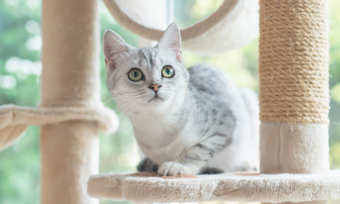Most of us consider our cats and dogs to be family members. And because they’re part of the family, we love to look after them the best we can. Whether that’s by opting for a gourmet kibble, buying them a branded doggy coat for winter, or taking them for regular vet check-ups.
The only issue is that a trip to the vet doesn’t come cheap. Not only can it set you back a lot more than a GP visit, but when we break a bone we have A&E, which is free. Our dogs aren’t so lucky.
That’s when a pet insurance plan can help. Not only can it cover any emergency surgeries but, depending on the plan you choose, it can even cover a teeth cleaning, too!
How much does pet insurance cost?
Depending on a variety of factors, you could pay anything from $10-$20 a month to over $100 a month to insure your dog. Cats tend to be at the lower end of the spectrum, but costs can still vary greatly between breeds.
To help get a better idea of what you can expect to pay, and how to mitigate costs, we spoke with the insurance experts at Cove Insurance.
Compare Pet Insurance Providers
What factors impact the price of pet insurance?
According to Cove, the main pricing factors in pet insurance are:
- Breed
- Age
- Gender
- Whether the dog/cat is desexed
Because the main factors are heavily dependent on the pet, Cove encourages Kiwis to check the cost of insuring any new pet before deciding to adopt. Cove says: “There can be a $100 price difference per month in insuring one dog relative to another.”
Although there are a few tips and tricks to help cut costs once you’ve adopted a new pet (which we get to below), ideally you should organise your pet insurance before you take your new furry family member home. This way, you can choose a new pet that isn’t going to cost you a second mortgage in ongoing expenses.
Breed
Dogs
“When it comes to breeds, some dogs are predisposed to certain conditions, which makes them more expensive to own and insure,” says Cove. Overall, there are three key considerations that affect the cost of insuring a pet dog:
- Size / weight – mo’ dog, mo’ problems. In general, larger, heavier breeds tend to cost more to insure, as they are more predisposed to bone, joint and growth issues, which are expensive to fix. For example St Bernards are known to develop more issues over time, compared to Jack Russells.
- Hereditary issues – there are plenty of well-known examples, such as pugs and French bulldogs whose adorable smooshed-up faces have left them with an array of health issues, which make them one of the most expensive dog breeds to insure.
- Class of dog – dogs bred for sheep herding, compared to just companion pooches, end up living different lives based on their activity levels.
Cheapest to insure:
|
Most expensive to insure
|
Data courtesy of Cove Insurance
Cats
When it comes to cats, certain breeds are more expensive to insure for the same health reasons. For example, hairless cats are susceptible to sunburn. And Siamese cats are known to suffer from psychogenic alopecia, an issue that can lead them to overgroom to the point of baldness, potentially leading to infections and other issues.
Furthermore, cats that are white with blue eyes, such as the Khao Manee, while stunning to look at, are also commonly deaf. This is a result of a genetic disorder to the W (for white) gene that blue-eyed white cats suffer from. Naturally, this opens them up to a variety of added risks in their environments.
All of these factors (among an array of other potential health issues) can make for a costly insurance policy:
Cheapest to insure:
|
Most expensive to insure:
|
Data courtesy of Cove Insurance
Age
“As pets age, they get more expensive to insure as their bodies weaken, making them more prone to accidents and illness,” says Cove.
Much like we tend to make more trips to the doctor as we get older, so do our pets. Almost all pets are likely to cost more in vet bills as they age, but if you’re looking to adopt an already elderly dog, not all breeds will cost the same. According to Cove, “There is a wide variety of breeds, and some age much better than others.”
Extremely young cats and dogs can also be expensive to insure if you tick all the insurance extras to cover things such as vaccinations, desexing and microchipping. It’s worth weighing up the insurance costs for such benefits, to see whether it works out cheaper to cover these expenses out of pocket.
Gender
Interestingly, male cats and dogs can cost more to insure. And, depending on the pet’s age, this can be significant. Cove says that there is a “wide discrepancy in how male and female animals age … which emerges once the pet is around seven years of age”.
Because of this, the difference in premiums between male and female dogs can be as much as 40%. However, Cove’s approach is to take a middle-market approach: it charges 5% extra to insure male pets.
De-sexed
Somewhat linked to gender, animals that haven’t been de-sexed can cost more to insure. This is due largely to the added behavioural issues that can come from animals in heat. Particularly males, who can be more territorial and aggressive, raising the risk of them getting into fights with other animals.
There are also certain health issues that are more common in un-neutered pets, such as mammary tumours or infected uteri in females. Or testicular cancer and prostate issues in males.
I already have a pet but I want to save on my pet insurance. What can I do?
If you’re reading this article while sitting on the sofa with a pug on your lap, you’ve likely already locked in high pet insurance premiums. As the breed of your pet plays a big part in its insurance costs. And pugs are about as expensive as they come.
But that doesn’t mean you can’t take other measures to bring down your costs. Sure, you won’t bring your payments down in line with a young Jack Russell, but you can certainly make savings.
And even if you do have a Jack Russell, there’s still plenty you can do to save.
Consider your pet insurance policy
Broadly speaking, there are three categories of pet insurance:
- Accident-only: most basic package provides cover for accidents and injuries
- Accident and illness: cover for accidents and injuries as well as illness, including serious health conditions. Note that pre-existing conditions are not covered
- Comprehensive: Cover for all of the above, as well as cover for many routine expenses, such as vaccinations, check-ups, dental care and more
Depending on your pet, and how often you take it in for routine care, you may not feel you require a comprehensive policy. And if your pet is young and healthy, you may find an accident-only policy is right for you.
Bundle with other insurance policies
Many insurance providers offer discounts and incentives for taking out multiple policies. This could be anything from car insurance to home and contents. For example, Cove gives you a 10% discount when you take out more than one policy with them.
Take out your insurance policy while your pet is young
Pet insurance doesn’t provide cover for pre-existing medical conditions. So if your pet already suffers from joint issues, don’t expect your pet insurance to cover any associated veterinary bills. However, by signing up for pet insurance while your pet is still young, you will be covered for any conditi0ns that may arise as it ages.
Do note that you’ll need to stay with the same provider and ensure your policy doesn’t lapse for this to work. Also, there may also still be certain conditions that aren’t covered by your insurance, especially for animals genetically prone to certain ailments. So be sure to ask questions and to check your policy carefully.
Change your excess, co-pay share, and/or annual limit
There are multiple different policy adjustments you can make to bring down your premiums. But bear in mind these might cost you more down the line:
- Raise your excess: lowers your premiums, but increases the amount you have to pay before your insurance kicks in
- Lower your annual limit: lower the amount you can claim in a year. Do note that any serious vet bills could blow out your yearly limit, leaving you to stump up the rest
- Raise your co-pay share: pet insurance doesn’t cover a vet’s bill in its entirety. Usually, you have to pay around 10%-20%. But some providers let you adjust this amount. For example, you could choose to pay up to 40% of each bill, which in turn would lower your premiums.
Pay your premiums in an annual lump sum
Some providers offer a discount if you pay upfront, instead of in regular instalments.
Shop around and compare pet insurance providers
Pet insurance doesn’t come at a fixed price. And each provider will likely quote a different price. So it’s important to shop around to find the best deal.
Keep in mind that there’s more than just price to consider. Levels of coverage differ between policies and providers, as do benefits, customer service, online tools and more.
And a great place to start comparing pet insurance is right here with Canstar. Each year, we compare pet insurance providers to discover which ones deliver the best customer service and value for money. So to get comparing, or to read more helpful articles and guides on pet insurance, simply hit the button below:
Compare Pet Insurance Providers
About the author of this page
This report was written by Canstar Content Producer, Caitlin Bingham. Caitlin is an experienced writer whose passion for creativity led her to study communication and journalism. She began her career freelancing as a content writer, before joining the Canstar team.
Enjoy reading this article?
You can like us on Facebook and get social, or sign up to receive more news like this straight to your inbox.
By subscribing you agree to the Canstar Privacy Policy










Share this article